Soft and fluffy homemade gluten-free hamburger buns that come together in less than an hour! Now you'll never have to miss out on burger night with this hamburger bun recipe. Made with an enriched yeasted dough, you'll never want store-bought buns again!
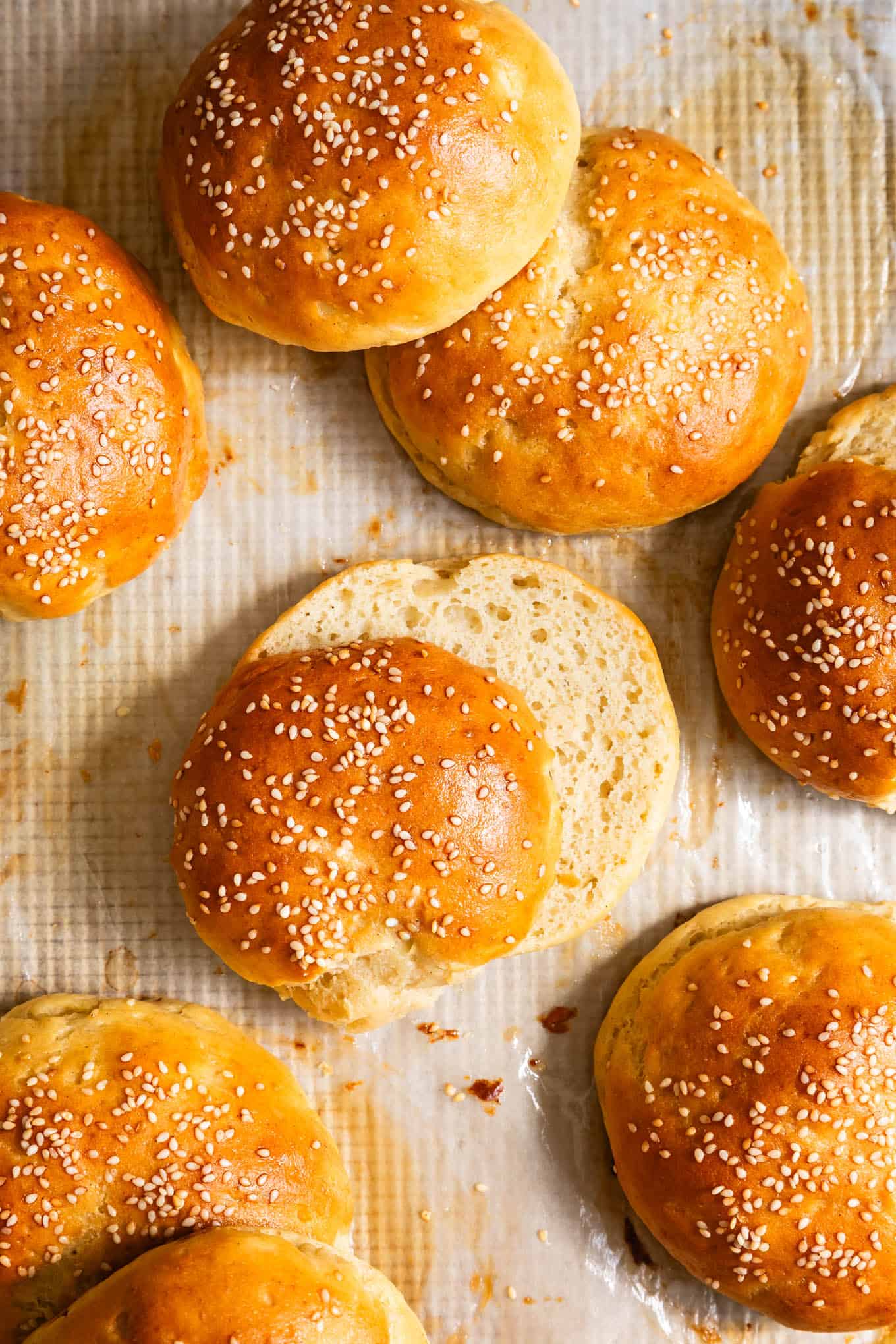
Store-bought gluten-free hamburger buns leave much to be desired, often dense and dry. And until now, I'd always opt for a lettuce wrap over a bun. Now, though, I can have homemade gluten-free burger buns that are soft and fluffy with a buttery golden-brown crust ready in an hour. And so can you.
This recipe is a long time coming. Over the last 2½ years, I've tested and tweaked over 30 batches of buns to get it exactly right, testing variations and substitutions along the way. Now I can confidently say that this is the best recipe for homemade gluten-free hamburger buns.
Best gluten-free hamburger buns
With a single rise, these hamburger buns are ready in just 1 hour, with only about 15 minutes of hands-on time. The result is a brioche-like bun that's rich and flavorful, yet fluffy and tender. A thin golden brown crust gives way to a soft and chewy crumb.


Ingredients for homemade gluten-free hamburger buns
- Active dry yeast, sugar, and warm milk: The sugar and warm milk (105-110°F) activate the yeast, which is the leavener that allows the dough to rise, creating those fluffy air pockets.
- Brown Rice Flour: Brown rice flour is a great neutral whole grain flour for bread because it bakes up neither gummy nor gritty and it soaks up the moisture nicely.
- Sorghum Flour or Gluten-Free Oat Flour: I've tested the recipe using either sorghum flour or gluten-free oat flour, and they're virtually indistinguishable! Both add more nutrients and flavor. Sorghum flour is a wholesome and whole grain that has slightly sweet notes that add flavor depth. Oat flour is a whole grain that adds, warm, slightly nutty, wholesome notes.
- Tapioca Flour and Potato Starch: For starches, use a combination of tapioca flour and potato starch. Tapioca starch, one of my go-to flours for gluten-free baking, is a fluffy starch that adds chewiness to baked goods. Just like when baking sourdough, I found that combining the tapioca flour with potato starch produced a more flavorful hamburger bun with a better texture. If you can't find or don't have potato starch, you can sub in additional tapioca flour by weight.
- Sweet Rice Flour: Made from sticky rice, sweet rice flour is distinctively different than white rice or brown rice flour, and despite its name, it's not sweet. Sometimes called "Mochiko," sweet rice flour is the same flour used to make mochi, and as such, its stickiness helps to bind dough together. In these hamburger buns, sweet rice flour adds chewiness like a classic brioche bun.
- Xanthan gum: These hamburger buns use xanthan gum as the binder to hold the dough together, adding chewiness that mimics gluten.
- Salt: Salt is essential. Mix kosher salt into the dough.
- Baking Powder: To help them rise just a little more
- Cream of Tartar: Cream of tartar is an acid and acts as a natural leavening agent, helping add more loft to the buns.
- Eggs & Egg Whites: The combination of whole eggs and egg whites is essential to creating a crumb that's moist, yet bakes up tender and soft.
- Butter: Butter adds moisture and flavor to the dough. For a dairy-free version, sub in plant butter!
- Apple Cider Vinegar: Adding apple cider vinegar to the dough will help to strengthen it and slightly increase the acidity. This allows the yeast to grow easier, causing your buns to rise a bit better.

Using Milk in the Dough
Rather than using water, these hamburger buns call for an enriched dough using whole milk. The proteins in milk (caseins) can mimic gluten and help provide structure to the dough. From my experience testing gluten-free bread doughs with water versus milk, the milk aids in trapping the air, creating a better crumb texture of the baked dough.
Some people who are gluten-intolerant have to avoid milk because of the similarities between caseins and gluten so if you're one of those people, you can certainly make this recipe with either plant milk or water (I tested it with oat milk and water and both worked great!).
If using water, add 1 tablespoon less water (225g total). The recipe works well with water in place of the milk, but the buns are just not quite as lofty and fluffy, with a bit less flavor. That being said, unless you had them side by side, you might not notice!
Is Xanthan Gum Required?
Yes, for these gluten-free hamburger buns, you must use xanthan gum. While you only need a little bit, without the xanthan gum, the dough is loose and wet, and doesn't come together as a dough.
I tested versions (at least 5 different ways) with psyllium seed husks in place of the xanthan gum, but found the buns spread flat and had a much denser texture.
If you’re just starting out with gluten-free baking, I understand that the hefty price tag on xanthan gum might steer folks away from using their own homemade flour blends that call for it. If you're in that camp, just know it lasts for a long time! I keep it in my fridge and a bag lasts me almost 2 years, so if you plan on getting more serious about gluten-free baking, a little goes a long way. Each recipe typically only calls for ½-1 teaspoon.
If you cannot use xanthan gum, you could make my gluten-free bagels or even gluten-free focaccia - both of these benefit from the texture of psyllium seed husks and do not call for xanthan gum.
Flour substitutions for gluten-free hamburger buns
While I usually offer flour substitutions, I found that gluten-free hamburger buns drastically changed with substitutions to the flours used. For example, I tried subbing in Bob's Red Mill 1-to-1 gluten-free baking flour for all of the flours by weight, and found the result quite a bit denser.
That being said, you can use sorghum flour and oat flour interchangeably in this recipe without any compromises to texture or flavor.
Additionally, if you can't find or don't have potato starch, you can sub in additional tapioca flour by weight, but the results may not be quite as flavorful or fluffy.
Otherwise, I recommend using the exact flours and weights listed in the recipe for the fluffiest gluten-free hamburger buns.
If you feel overwhelmed about buying three flours you might not use, search my recipe index and you'll find over 100 recipes that use one of these flours.

How to make gluten-free hamburger buns
Activate the Yeast
The first step to making gluten-free hamburger buns is to activate the yeast. Mix in sugar and yeast to warm milk (105-110°F) and let it sit for 5-10 minutes until it starts foaming and bubbling on top. If the yeast does not foam, your yeast may have gone bad, and you should start over with a new batch of yeast.
Mixing the Dough
Mix all the dry ingredients together in a stand mixer then add the activated yeast and milk along with the remaining wet ingredients. Mix for several minutes with the paddle attachment. The dough will be very sticky.
Shape the buns with Tapioca Starch
Even more so than regular dough, this gluten-free dough will seem impossibly sticky. The trick is to dust everything from your work surface to the dough, to your hands generously with tapioca starch. By dusting the outside of the dough with flour, you're making it manageable to touch, while not working that extra flour into the dough, which would create a dense bun.
Set a bowl of tapioca starch near your workstation. Scoop and weigh 105 - 115g of dough onto the tapioca-dusted plate. Dust with tapioca flour, then, with floured hands, pick up the bun and shape it.
Gently flatten the dough, then fold and pinch each edge into the center. Flip the bun over so this pinch is on the bottom and use cupped hands to round the dough into a smooth ball (either rotating it against the floured table or against your other hand), adding more tapioca starch to your hands as needed. Place, seam-side down, on the parchment-lined baking sheet and repeat.
Note: any seams or creases on top or on the sides of the bun may lead to a crack in the oven. If this happens, don't fear! This more rustic look won't affect the texture or flavor of the bun at all.
You may find you need to wash and re-flour your hands after a couple of buns if the dough is sticking to them.
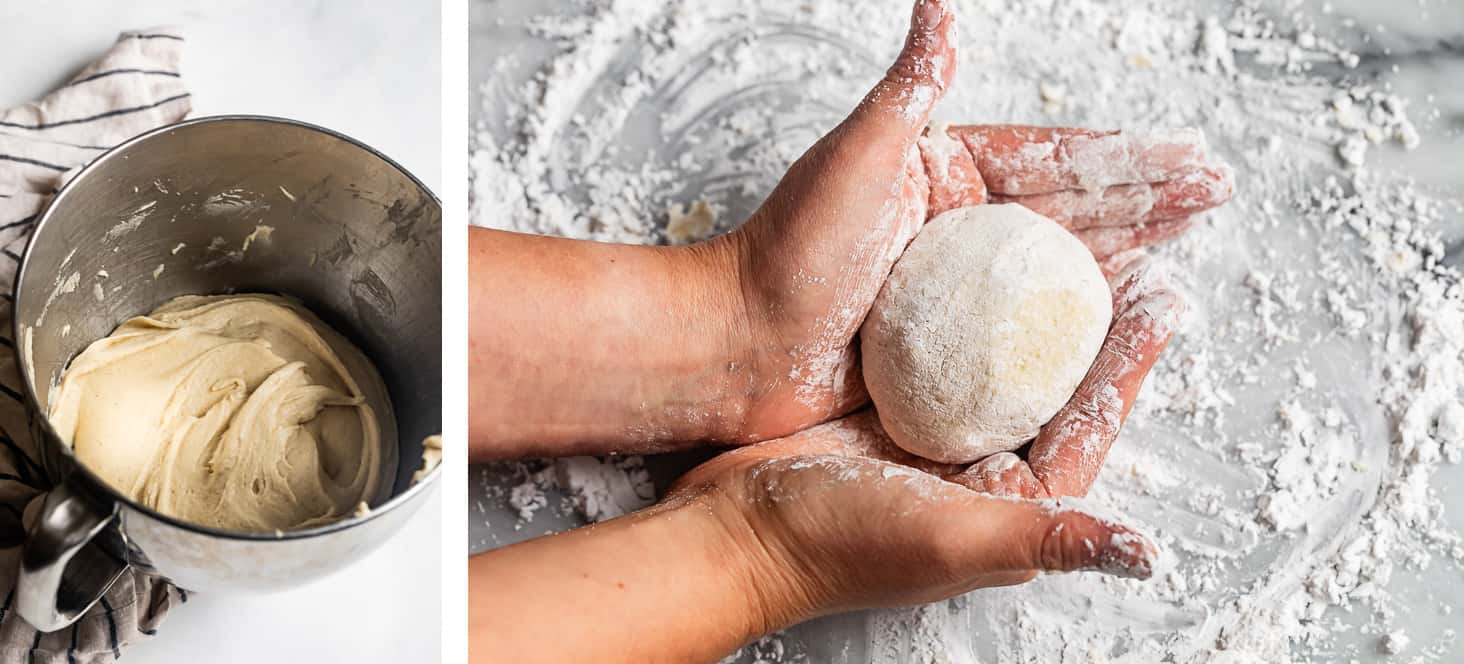

Rise
When making gluten-free yeasted dough, you want to encourage trapping as much air into the rise as possible. The double rise of regular dough creates a finer gluten structure, so you don't end up with large air bubbles. Except we aren't using gluten here! And we want more air bubbles.
For that reason, we shape the buns before the rise so we don't disturb that beautiful rise later. Spray buns lightly with cooking oil, then cover loosely with plastic wrap, and let rise for just 30 minutes in a warm place (I use the proof setting on my oven).
Take care not to overproof the buns or you'll end up with flatter buns with many cracks in the top. If your kitchen is extra warm, you may only need 20 minutes of rise time.
Egg White Wash & Topping
Brushing the risen buns with eggs enhances the glossy golden brown color and helps the sesame seeds stick to the top!
Bake & Brush with butter
Now they bake until deeply golden brown, about 16-18 minutes. Rotate the pan about 12 minutes in to encourage even browning. As soon as the buns come out of the oven, brush them with melted butter. This helps soften the crust, enhances the sheen, and adds delicious flavor the the buns!
Cool before slicing
Let the buns cool about 15 minutes, until just cool to the touch on the outside, before slicing and serving. If you slice the buns while hot out of the oven, the crumb won't set and the inside will seem gummy. Letting them cool for 15 minutes is essential.
Can I make this dough without a stand mixer?
I recommend a stand mixer to make this yeasted dough, but you can also use a hand mixer or a food processor. The dough will be very sticky, so kneading it by hand would be very difficult.
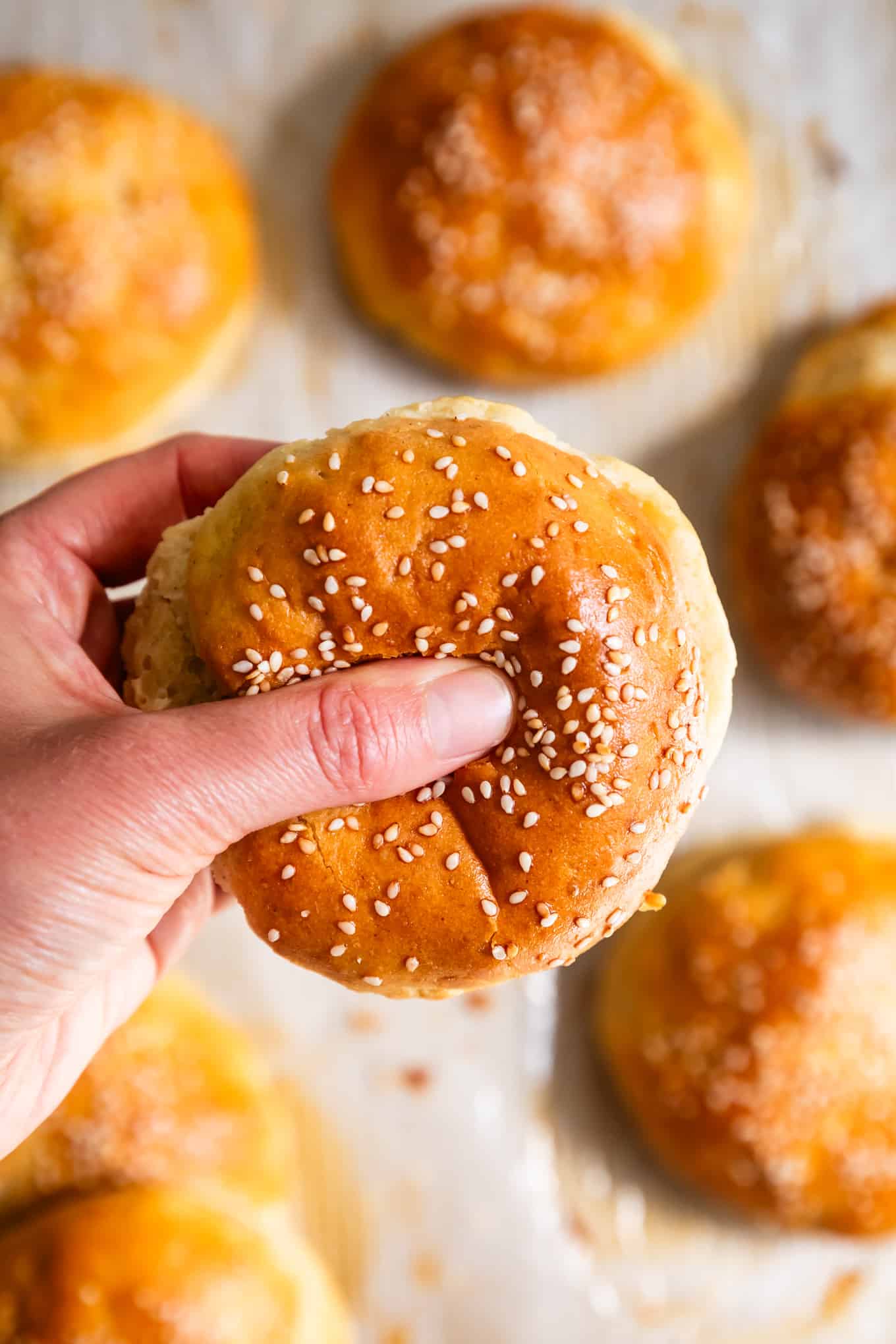

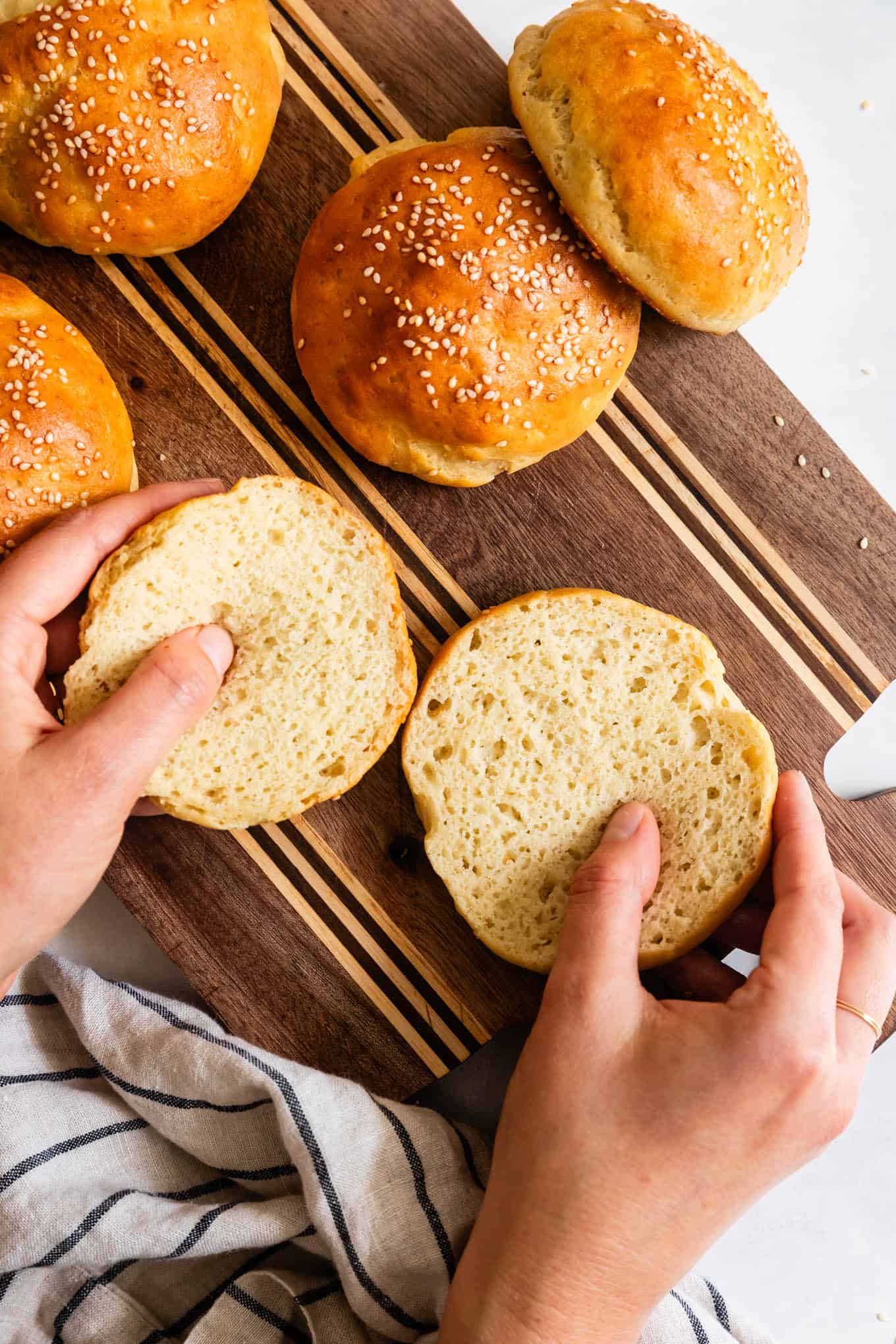

How to make dough in advance
You can also make the dough in advance to make your weeknight dinner prep even quicker! Make the entire dough, shape the buns, and let them rise, covered, for 10 minutes on the baking sheets. At this point, chill the dough for up to 24 hours. Chilling will pause the rise, so you can bake the buns at a later time.
When you're ready to bake, remove the dough buns from the fridge and let it sit at room temp for 30 minutes before baking.
Dairy-Free Gluten-Free Hamburger buns
This recipe is super easy to make dairy-free! Sub out the milk for plant milk such as oat milk or almond milk, and the butter for plant butter. The dairy-free buns were almost indistinguishable from the dairy-full version, with slightly less rise (a comparison really only noticeable side-by-side!).
How to store gluten-free hamburger buns
These buns are best served lightly warm, but you may store buns for later use. As the buns cool, they'll become denser, but lightly warming or toasting the buns will bring back their soft squishy texture.
Buns can be stored in an airtight container at room temperature for up to 2 days. However, for best results, slice the buns and immediately store them in an airtight freezer bag or container for up to 4 months.
When ready to serve, pop the frozen buns in the toaster, defrost them in the microwave, or toast over a grill before serving to restore the soft tender crumb.

Other ways to use these gluten-free buns
These yeasted buns are endlessly versatile! They also make great sandwich rolls and dinner rolls.
This week I even cut up some of our leftovers and toasted them to make croutons!
More Gluten-Free Yeast Dough Recipes
Recipe

Gluten-Free Hamburger Buns
Ingredients
- 1 cup (240 g) whole milk, warmed to 105-115°F (or sub in 240g plant milk or 225g water)
- 1 tablespoons + 2 teaspoons active dry yeast
- ¼ cup granulated sugar, divided
- 140 g (¾ cup + 2 tablespoons) Bob's Red Mill brown rice flour
- 119 g (1 cup + 1 tablespoon) Bob’s Red Mill tapioca flour, plus more for rolling
- 80 g (½ cup + 2 tablespoons) Bob's Red Mill sorghum flour or Bob's Red Mill Gluten-Free Oat Flour
- 78 g (½ cup) Bob's Red Mill potato starch
- 60 g (¼ cup + 2 tablespoons) sweet rice flour, also called "Mochiko" - distinctly different from brown rice flour or white rice flour! I use Koda Farms brand
- 1½ teaspoons xanthan gum
- 1½ teaspoons kosher salt
- ½ teaspoon baking powder
- ¼ teaspoon cream of tartar
- 2 large eggs, room temperature
- 2 large egg whites, room temperature
- 6 tablespoons (84 g) unsalted butter, melted (or sub plant butter)
- 1 tablespoon apple cider vinegar
- Cooking spray
- 1 large egg, room temperature
- 1 tablespoon water
- 2 tablespoons raw sesame seeds
- 2 tablespoons unsalted butter, melted (or sub plant butter)
INSTRUCTIONS
- Preheat oven to proof setting, if available, and line two light colored baking sheets with parchment paper.
- Activate the yeast. In a medium bowl, mix together the warm milk (105°-115°F), 1 tablespoon of the sugar, and yeast. Let sit for 5-10 minutes while the yeast activates and foams. Note: If your yeast hasn't foamed up after 10 minutes, your yeast may have gone bad and you should try again with different yeast.
- Mix dry ingredients. In the bowl of a stand mixer fitted with the paddle attachment, mix together all of the dry ingredients: remaining 3 tablespoons sugar, brown rice flour, tapioca flour, potato starch, sorghum flour, sweet rice flour, xanthan gum, salt, baking powder, and cream of tartar.
- Make the dough. Once the yeast has foamed, add the yeast to the stand mixer followed by eggs, egg whites, melted butter, and apple cider vinegar. Mix on low-speed, increasing to medium-high for 4 minutes, scraping down the sides as needed. The dough will be very soft and sticky - much too sticky to handle without floured hands.
- Shape the buns. Set a bowl of tapioca starch near your workstation and dust your work surface with tapioca starch. I recommend weighing your dough to make each bun the same size. To do so, place a small plate dusted with tapioca starch on top of your kitchen scale. Use a ⅓ cup measuring cup measure to scoop 105 - 115g of dough onto the tapioca-dusted plate. Dust the outside of the dough with additional tapioca flour, then, with tapioca-covered hands, pick up the bun and shape it. Gently flatten the dough, then fold and pinch each edge into the center. Flip the bun over so this pinch is on the bottom and use cupped hands to round the dough into a smooth ball (either rotating it against the floured table or against your other hand), adding more tapioca starch to your hands as needed. Place, seam-side down, on the parchment-lined baking sheet and repeat. Note: any seams or creases on top or on the sides of the bun may lead to a crack in the oven. If this happens, don't fear! This more rustic look won't affect the texture or flavor of the bun at all. You may find you need to wash and re-flour your hands after a couple of buns if the dough is sticking to them.
- Rise. Spray buns lightly with cooking oil, then cover loosely with plastic wrap. Place in a warm place to proof for 30 minutes (I use the proof setting on my oven). The buns should puff up significantly. Note: if making the dough in advance, proof only for 10 minutes, then transfer to the fridge for up to 24 hours. Pull them out of the fridge to proof 25 minutes before baking. When the buns are nearly proofed, preheat the oven to 375*F.
- Brush with egg wash. Whisk together 1 large egg and a tablespoon of water. Gently brush each bun with the egg wash on the entire surface, then sprinkle generously with raw sesame seeds.
- Bake. Bake for 16-18 minutes, until the buns are deeply golden brown, rotating the pan after about 12 minutes to encourage even browning.
- Brush with butter. Right when the buns come out of the oven, brush them with melted butter.
- Let cool and slice. Let cool until just cool to the touch on the outside, about 15 minutes, then slice and serve (Note: if you try to slice the buns too soon out of the oven, the crumb won't set and the inside will seem gummy. Letting them cool for 15 minutes is essential). These buns are best served lightly warm, but you may store buns for later use. As the buns cool, they'll become denser, but lightly warming or toasting the buns will bring back their soft squishy texture! See additional storage tips below.
Notes
Nutrition








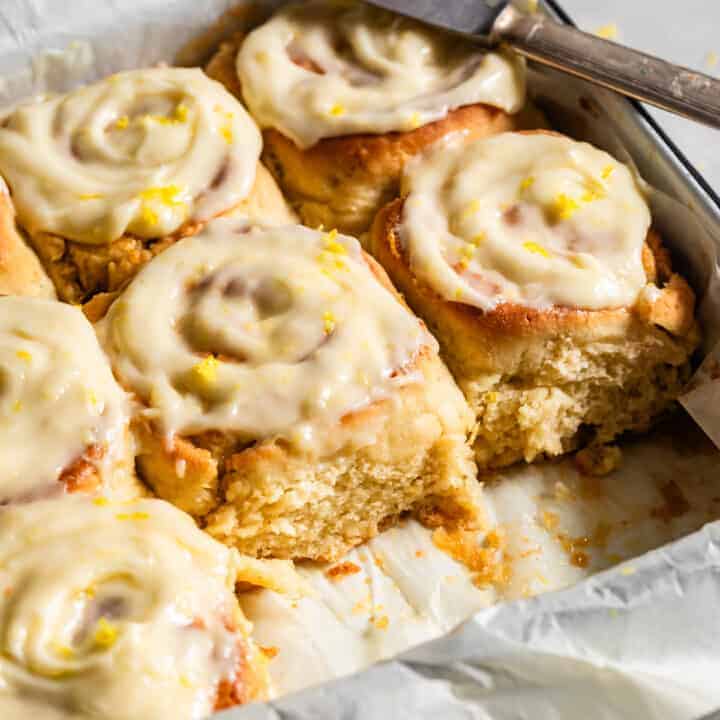
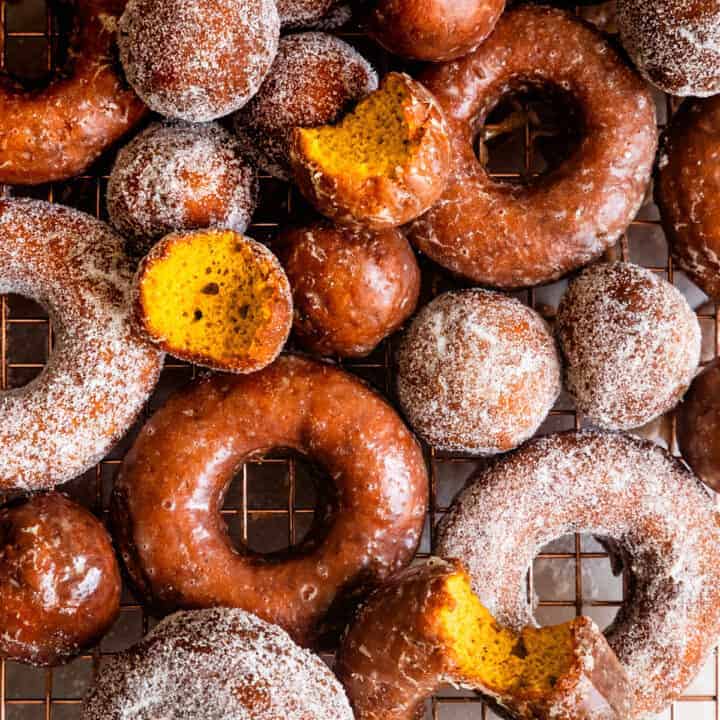


Debbie Feely -
Sounds awesome Sarah! I’m intolerant to brown rice and eggs. I’ve read white rice will sub for the brown… but probably no hope for eggs, right? I also can’t do flax or legumes.
Sarah Menanix -
I wish I had an answer for you! Sadly I've not had good luck making egg-free gf bread. In my experience they're a lot less tender than these buns.
Debbie Feely -
Same. Everything I’ve seen indicates brown rice and eggs is the way to go. These look amazing. I’m sure many will be happy to try them.
Cody -
What about trying psyllium husk?
Sarah Menanix -
I tested versions (at least 5 different ways) with psyllium seed husks in place of the xanthan gum, but found the buns spread flat and had a much denser texture.
Meg -
I can’t find the oat flour.. would bobs red mill’s 1 to 1 work? Or what can I use in place of that?
Sarah Menanix -
I've tested the recipe using either sorghum flour or gluten-free oat flour, and they're virtually indistinguishable! Alternatively, you can grind your own oat flour by pulsing gf rolled oats in a food processor or high-powered blender until fine and then sifting out any large pieces. I wouldn't recommend 1 to 1 as it is a mix of flours and gf breads can be finicky!